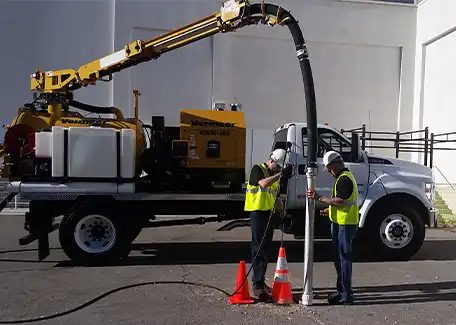Air and hydro vacuum excavation (VacEx) are digging methods using high-pressure air or water to loosen soil that is then vacuumed out of a hole, pit, or trench to reveal what is buried. Most VacEx uses trucks containing an air compressor, water jet, and a high-strength vacuum with a holding tank.

VacEx is predominantly used when potential damage to underground utilities or structures (assets) is possible, or the presence of underground structures or utilities is uncertain. Because of its minimal excavation footprint (approximately 12 to 18 inches), VacEx is used instead of traditional excavation methods, such as backhoes and trackhoes, when precise digging is required.
RETTEW commonly uses VacEx to confirm the exact location, depth, size, and material of a utility or structure after its location has been pinpointed using geophysical utility mapping techniques (e.g., electromagnetics, magnetics, radio frequency, metal detection, and ground penetrating radar). This information is critical when construction plans include tying into a utility, moving a utility, or building or installing across an existing utility. VacEx can be slower and costlier than traditional excavation methods; therefore, careful consideration is used to determine when it is best to apply this technology. Read on to learn how RETTEW used air and hydro vacuum excavation to help a client determine the best placement for a planned fiber optic loop around its medical facility campus.

Meet Joe Stipe
Geophysicist
Even though he likes that his job allows him to work outdoors and visit interesting places, you’ll never guess which television show he’s a huge fan of and watched 12 times in its entirety. Go “beneath the surface” to discover the answer and find out more about Joe!